
Chaitanya Mahaprabhu, born Vishvambhar Mishra, was a 15th-century Indian Hindu saint from Bengal who was the founder of Gaudiya Vaishnavism, which considers him to be an incarnation of Krishna.

Jayadeva, also spelt Jaideva, was a Sanskrit poet during the 12th century. He is most known for his epic poem Gita Govinda which concentrates on Krishna's love with the gopi, Radha, in a rite of spring. This poem, which presents the view that Radha is greater than Krishna, is considered an important text in the Bhakti movement of Hinduism.

Upendrakishore Ray Chowdhury was a Bengali writer, painter and entrepreneur. One of his written books is Chotoder Shera Bigyan Rochona Shongkolon. He was the son-in-law of reformer Dwarkanath Ganguly. He was also an entrepreneur. He was the first person who introduced color printing in Bengal. He started the first colour children's magazine Sandesh in 1913.

The Bengal Renaissance, also known as the Bengali Renaissance, was a cultural, social, intellectual, and artistic movement that took place in the Bengal region of the British Raj, from the late 18th century to the early 20th century. Historians have traced the beginnings of the movement to the victory of the British East India Company at the 1757 Battle of Plassey, as well as the works of reformer Raja Rammohan Roy, considered the "Father of the Bengal Renaissance," born in 1772. Nitish Sengupta stated that the movement "can be said to have … ended with Rabindranath Tagore," Asia's first Nobel laureate.

Rarh region is a toponym for an area in the Indian subcontinent that lies between the Chota Nagpur Plateau on the West and the Ganges Delta on the East. Although the boundaries of the region have been defined differently according to various sources throughout history, it is mainly coextensive with the state of West Bengal, also comprising parts of the state of Jharkhand in India.
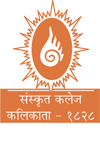
Sanskrit College and University is a state university located in Kolkata, West Bengal, India. It focuses on liberal arts, offering both UG and PG degrees in Ancient Indian and world history, Bengali, English, Sanskrit, Linguistics, and traditional orientation learning except Pali in which only UG degree is being offered.

Nabadwip, also spelt Navadwip, anciently Nadia or Nudiya, is a heritage city in Nadia district in the Indian state of West Bengal. It is regarded as a holy place by Hindus, and is the birthplace of Chaitanya Mahaprabhu. Famous for Rass festival where city is illuminated with lights, deities of God and goddesses are made on each corner of Nabadwip town. Hundreds of people gather to this small town on the occasion of raas utsab. Located on the western bank of the Hooghly River, it is considered to have been founded in 1063 CE, and served as the old capital of the Sena dynasty. A center of learning and philosophy in medieval India, the city is still noted for its traditional Sanskrit schools. The Navya Nyaya school of logic reached its peak with the efforts of some well known contemporary philosophers of Nabadwip. The great Vaishnava saint, social reformer and an important figure of the Bhakti movement, Chaitanya Mahaprabhu (1486–1534) was born here. It was after Chaitanya Mahaprabhu's birth that Nabadwip became an important center of pilgrimage for the Vaishnavas worldwide as well as for Hindus in general. Many who follow Gaudiya Vaishnavism visit Nabadwip to celebrate the auspicious birthday day of Shri Mahaprabhu, which, as per lunar calculations, occurs on Phalguni Purnima. This day is commonly known as Gaura-purnima. Aside from this, Nabadwip is visited for various other festivals like Dol Jatra and Rash purnima.
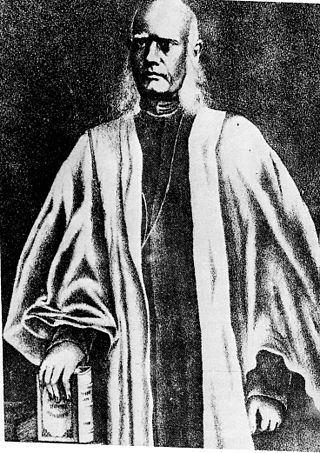
Krishna Mohan Banerjee was a 19th-century Indian thinker who attempted to rethink Hindu philosophy, religion and ethics in response to the stimulus of Christian ideas. He himself became a Christian, and was the first president of the Bengal Christian Association, which was administered and financed by Indians. He was a prominent member of Henry Louis Vivian Derozio's (1808–1831) Young Bengal group, educationist, linguist and Christian missionary.
The birthplace of the twelfth-century Sanskrit poet Jayadeva, author of the Gitagovinda, has been disputed, with the neighboring states of Odisha, West Bengal in eastern India and the region of Mithila staking a claim. This had led to a bitter feud between people on both sides that lasted for over a century. The issue is still debated by scholars.

Romesh Chunder Dutt was an Indian civil servant, economic historian, translator of Ramayana and Mahabharata. He was one of the prominent proponents of Indian economic nationalism.
Raghunatha Shiromani was an Indian philosopher and logician. He was the head of the Ancient Mithila University also known as Mithila Vidyapeeth. He was born in a brahmin family at Nabadwip in present-day Nadia district of West Bengal state. He was the grandson of Śulapāṇi, a noted writer on Smṛti from his mother's side. He was a pupil of Vāsudeva Sārvabhauma. He brought the new school of Nyaya, Navya Nyāya, representing the final development of Indian formal logic, to its zenith of analytic power.
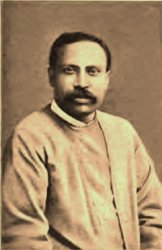
Sarat Chandra Dash was an Indian scholar of Tibetan language and culture most noted for his two journeys to Tibet in 1879 and in 1881–1882.

Pathuriaghata is a neighbourhood of North Kolkata in Kolkata district, in the Indian state of West Bengal. It is one of the oldest residential areas in what was Sutanuti. Once the abode of the Bengali rich, the neighbourhood and its surrounding areas are now dominated by Marwaris. Even in the 21st century the area is replete with colonnaded mansions.

Maharaja Bahadur Sir Jatindramohan Tagore was a theatre enthusiast, art-lover, and philanthropist from Bengal region of the Indian subcontinent.
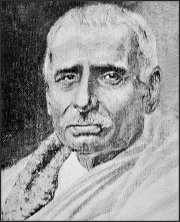
Hara Prasad Shastri, also known as Hara Prasad Bhattacharya, was an Indian academic, Sanskrit scholar, archivist, and historian of Bengali literature. He is most known for discovering the Charyapada, the earliest known examples of Bengali literature.
Adi Dharm refers to the religion of Adi Brahmo Samaj the first development of Brahmoism and includes those Sadharan Brahmo Samajists who were reintegrated into Brahmoism after the second schism of 1878 at the instance of Devendranath Tagore. This was the first organised casteless movement in British India and reverberated from its heart of Bengal to Assam, Bombay State, Punjab and Madras, Hyderabad, and Bangalore.

Jalaluddin Muhammad Shah was a 15th-century Sultan of Bengal and an important figure in medieval Bengali history. Born a Hindu to his aristocratic father Raja Ganesha, the patriarch of the Ganesha dynasty, he assumed the throne of Bengal after a coup which overthrew the Ilyas Shahi dynasty. He converted to Islam and ruled the Bengal Sultanate for 16 years. As a Muslim king, he brought Arakan under Bengali suzerainty and consolidated the kingdom's domestic administrative centres. He pursued relations with the Timurid Empire, Mamluk Egypt and Ming China. Bengal grew in wealth and population during his reign. He also combined Bengali and Islamic architecture.
Brajabuli is an artificial literary language popularized by the Maithili poet Vidyapati. His Brajabuli lyrics about the love for Radha Krishna is considered to his best of works. Other poets emulated his writing, and the language became established in the 16th century. Among the medieval Bengali poets who wrote in Brajabuli are Narottama Dasa, Balarama Das, Jnanadas, and Gobindadas Kabiraj.
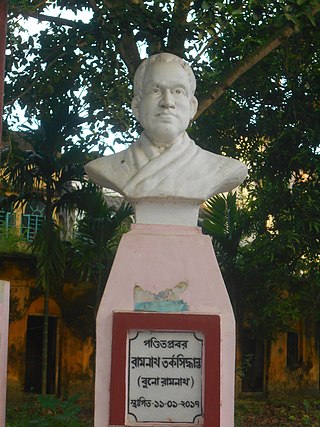
Ramnath Tarkasiddhanta, popularly known as Buno Ramnath, was a prominent logician, scholar and ideal teacher of Nabadwip in the eighteenth century. He was called Buno as he had set up his Chatuspathi in a forest area.
Vasudeva Sarvabhauma was an Indian Philosopher and a scholar of Nyaya Shastra. He is also known as Sarvabhauma Bhattacharya. He lived around 13th to 14th century of the Common Era. He belonged to Nabadwip and went to Mithila for studying Nyaya Shastra in Ancient Mithila University. He was a student of Pakshadhara Mishra, the head professor of Nyaya Shastra in the Ancient Mithila University at that time. He memorized the entire texts of learning available there and then returned to Nabadwip to establish his own school for the study of logic He was one of the founders of Navya Nyaya School of Indian Philosophy.















